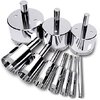Vulash
Arachnosquire
- Joined
- Aug 7, 2022
- Messages
- 76
There are some decent glass enclosures out there that only have top ventilation. When do you find these acceptable to use? I know folks use Exo Terra tall for some arboreals. What else do you use?
I rather like the Zoo Med "Creature Den" and recently picked up a Thrive Reptile Terrarium fairly cheap. Both of those have tops that aren't overlapped mesh, so they don't require modification in that regard. There is no cross-ventilation, however. (By "rather like" I mean the look, quality, dimensions, etc - not as in "I use them for all Ts). I've seen threads with discussions about the Reptizoo glass vertical enclosure that is good for fossorials.
I also recently picked up a cheap 2.5 gallon glass aquarium for experimentation. I attempted to drill some ventilation with a bit designed for glass. The issue is that the glass isn't very well supported in a pre-built enclosure like that. The glass broke in 2 out of 4 holes. There is no way I could confidently get enough holes for full ventilation without ruining the whole thing.
So again, when do you use these? Drier climate terrestrials? A GBB?
And knowing how much Avic and related Ts need cross-ventilation, when do folks decide it's okay to switch to Exo Terra? Once they reach adulthood?
These questions are more general, but I guess I'm wanting to understand the nuance of glass enclosures a bit more. So far, I'm not a huge fan of acrylic.
I rather like the Zoo Med "Creature Den" and recently picked up a Thrive Reptile Terrarium fairly cheap. Both of those have tops that aren't overlapped mesh, so they don't require modification in that regard. There is no cross-ventilation, however. (By "rather like" I mean the look, quality, dimensions, etc - not as in "I use them for all Ts). I've seen threads with discussions about the Reptizoo glass vertical enclosure that is good for fossorials.
I also recently picked up a cheap 2.5 gallon glass aquarium for experimentation. I attempted to drill some ventilation with a bit designed for glass. The issue is that the glass isn't very well supported in a pre-built enclosure like that. The glass broke in 2 out of 4 holes. There is no way I could confidently get enough holes for full ventilation without ruining the whole thing.
So again, when do you use these? Drier climate terrestrials? A GBB?
And knowing how much Avic and related Ts need cross-ventilation, when do folks decide it's okay to switch to Exo Terra? Once they reach adulthood?
These questions are more general, but I guess I'm wanting to understand the nuance of glass enclosures a bit more. So far, I'm not a huge fan of acrylic.




